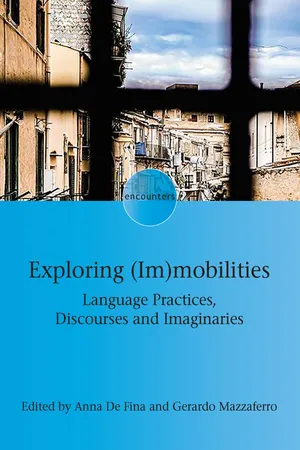![]()
Part 1
The (Im)mobilization of Language Resources, Repertoires and Practices
![]()
1Multilingual Young African Migrants: Between Mobility and Immobility
Mari D’Agostino
Introduction
This chapter is part of a broader study into new migration experiences and, in particular, that of young migrants who have recently arrived in Italy via the Mediterranean route. The main object under investigation is the linguistic and communicative resources available to these migrants at their point of departure, how these have been used and modified during their journey, and how they have been used and modified through the different phases of their life in Italy (see Amoruso & D’Agostino, 2017; D’Agostino, 2017, 2021a, 2021b; D’Agostino & Mocciaro, 2021). This is understood within the holistic entirety of an individual’s repertoire, according to the individuations provided by Brigitta Busch (2012, 2017). We will thus look at both the history and the biography of each speaker, at their cognitive and emotional dimensions and the ideologies and practices of both the subjects themselves and others: ‘The repertoire can thus be seen as a hypothetical structure, which evolves by experiencing language in interaction on a cognitive and on an emotional level and is inscribed into corporal memory and embodied as linguistic habitus and which includes traces of hegemonic discourses. These discourses are expressed in categorisations that are backed up by inclusive and exclusive language ideologies’ (Busch, 2012: 521). Busch concludes the same work by describing the repertoire as a ‘heteroglossic (…) space of potentialities’ which includes ‘imagination and desire’:
Drawing on a broad range of earlier voices, discourses, and codes, the linguistic repertoire forms a heteroglossic and contingent space of potentialities which includes imagination and desire, and to which speakers revert in specific situations. (Busch, 2012: 521)
The centrality held by a revised notion of repertoire within linguistic research today has been noted by many. Within a wide-spanning re-examination of the bases and methods of sociolinguistics, Hall et al. (2006: 232) defined repertoire(s) as ‘conventionalized constellations of semiotic resources for taking action – that are shaped by the particular practices in which individuals engage’ (see also Otsuij & Pennycook, 2010). Blommaert (2008, 2010) has also emphasised how the repertoire ought to be seen not from pre-established linguistic constructions (languages, dialects, variations) but through focusing our attention on resources in a continuous state of flux. In particular, Blommaert (2008: 16) refers to that which he calls a ‘polyglot repertoire’, which he claims cannot be associated to a particular national space, nor to a stable linguistic national order, but rather to the life of a single individual, following a particular human and social trajectory. This represents an important shift away from those models that bound (and bind) the concept instead to structure, system and regularity, moving instead towards approaches that put fluidity and creativity of individual and collective linguistic practice in the spotlight. This perspective is particularly important for the current research, which focuses on the analysis of linguistic behaviour among young people from African contexts, in which the complex expressed forms of multilingualism relating to the individual, space and discourse make it even more important to examine the fluidity of linguistic practices rather than abstract constructions and systems as such. This follows the suggestions of Lüpke and Storch (2013), who pick out two crucial questions for sociolinguistic studies of African contexts:
The first is that speakers’ profiles can be better described and understood in terms of registers and repertoires than in terms of discrete languages. The second observation is that just as there are no fixed languages or fixed linguistic identities, there is no fixed alignment of linguistic practice with ethnically or otherwise construed aspects of identity. (Lüpke & Storch, 2013: 2)
It is also important to bear a series of complex features in mind that characterise the forms of migration that we will be looking at in this study. For the young African migrants examined herein, the great experience of digital connection and spatial mobility is often accompanied by physical and spatial segregation. This first aspect has been frequently studied within the category of ‘connected migrants’, especially in Dana Diminescu’s (2008) essay, ‘The connected migrant: An epistemological manifesto’. The importance of this text is in non-defining migrants on the basis of physical and psychic experience alone, and on their un-rootedness. Over the past few decades we have learnt to think of the migrant as someone who lives in a double absence, excluded from the political and social order of both the locations they have inhabited and inhabit, and still more as someone who lives ‘in between’, in a no-man’s land, both within and outside of the conflicts that they continually traverse. We must now, however, begin to recognise this new dimension of living: being simultaneously here and there. Rather than characterising migration therefore through Abdelmalek Sayad’s (1999) famous image of the ‘double absence’, from both one’s own home and that of one’s host, the use of digital technologies seems to indicate a ‘portability of the...
